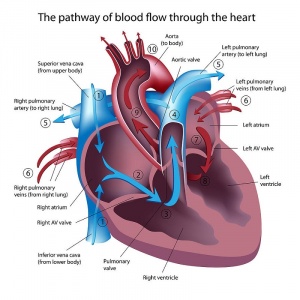Introduction
Congestive heart failure (CHF) is a condition in which the heart can no longer sufficiently supply the body with the blood needed to maintain homeostasis. This condition can result from other cardiovascular complications such as infarctions, valve defects, lung disease, and hypertension. Left-sided heart failure occurs more frequently than right-sided, creating symptoms like shortness of breath and irregular heart rhythm which can induce compensatory mechanisms of the body. This compensation begins with a decrease in systemic blood flow as a result of increased peripheral resistance or congestion in the pulmonary system. This reduced blood flow to the kidneys will stimulate the release of renin and aldosterone, both of which increase the workload on the heart by increasing blood volume and peripheral resistance via vasoconstriction. Newly imposed demands weaken the left ventricle and create congestion within in the pulmonary system. Backflow into the pulmonary system causes an increase in resistance and in turn results in right-sided heart failure[1].
Statistics – The extent of the problem of CHF
CHF is an epidemic spread across the entire world It is estimated that 40 million people[3] in the world are afflicted with CHF, approximately 5.8 million of them being from the United States. In Australia between 1% and 2 % of the population are affected by CHF, with burden of heart failure greatest among Indigenous Australians (age-standardized prevalence rate ratio of 1.7), women and in rural and remote regions than in the metropolitan and capital territories.[4] In China Heart failure (HF) there are ~4,500,000 individuals with HF, equating to a prevalence of 0.9%[3]
The total cost of care for those with CHF is approximately $30.7 billion, and that value is expected to reach $69.8 billion by 2030. About 1% of people aged 55-64 and 17.4% of people 85 and older suffer from heart failure[5].
Physical therapy can play a key role in improving the well-being and quality of life for patients who are diagnosed with CHF. Patients who have a biventricular pacemaker implant, which helps to synchronize contractions between the left and right sides of the heart, are often cleared for therapeutic exercise.
Risk Factors
Risk factors for developing CHF include:
Contraindications and Considerations for Physiotherapy
Therapists should be aware of red flags such as infection, malfunction, and contraindications with electric modalities for these devices during therapy sessions. In addition, decreased muscle mass, VO2peak, quality of life, and exercise capacity are factors that the therapist should take into consideration for treatment[7].
Medication
Beta-blockers, ACE inhibitors, glycosides, and diuretics are the key medications used for managing congestive heart failure through regulating renal function and the sympathetic nervous system. Adverse effects of these drugs are covered in the below links, providing implications of each drug in regards to physical therapy activity.
Beta-Blockers in the treatment of congestive heart failure
ACE Inhibitors in the treatment of congestive heart failure
Glycosides in the treatment of congestive heart failure
Aldosterone Receptor Antagonist Diuretics in the treatment of congestive heart failure
Patient Recommendations for Congestive Heart Failure
Conclusion
The prevalence and seriousness of CHF diagnosis warrant the dedication of physical therapists to continually develop the competencies needed to safely and effectively treat patients with this condition. Decreased tolerance for physical activity is a primary symptom of CHF with several implications for the physical therapist. As movement specialists, physical therapists utilize their knowledge and skills to prescribe exercise to meet a variety of patient goals. Consequently, a core component of physical therapy treatment is likely to be significantly influenced by the decreased movement capacity associated with CHF. Therapists must be astute in selection of exercise type and intensity to ensure a program that provides a sufficient stimulus but can be performed safely within the patient’s current abilities, without discouraging the patient or causing ill effect. Additionally, the status of a patient’s chief complaint must be considered in the context of their CHF diagnosis. Therapists will need to discern through clinical reasoning whether changes in function are likely due to physical therapy treatment or are being more heavily influenced by CHF and its associated sequelae and pharmacotherapy. Such an assessment is necessary to evaluate the effectiveness of a physical therapy program, communicate with other members of the patient’s healthcare team, and make requisite modifications.
As part of an interdisciplinary team, it is also essential that physical therapists be knowledgeable regarding the pharmacological treatment of CHF. The drugs used to manage CHF work by increasing cardiac contractility or decreasing cardiac workload. These pharmacological effects may potentially allow for drug therapy and exercise therapy to have the mutually reinforcing benefits of increasing exercise tolerance and strengthening cardiac function. Despite these potential benefits, the drugs used to treat CHF may also cause serious side effects including dizziness, nausea, arrhythmias, fatigue, and weakness. Knowledge of these side effects will allow the therapist to consider the response to exercise prescription and other modalities in the context of the patient’s pharmacotherapy. Early recognition of these symptoms may prevent development of serious complications or even death.
References
- ↑ VanMeter, K. C., & Hubert, R. C. (2014). Gould’s Pathophysiology for the Health Professional. 5th ed. St. Louis, MO: Elsevier.
- ↑ Alila Medical Media Congestive Heart Failure: Left-sided vs Right-sided, Systolic vs Diastolic, Animation Available from: ↑ 3.03.1 Jackson JD, Cotton SE, Wirta SB, Proenca CC, Zhang M, Lahoz R, Calado FJ. ↑ Sahle BW, Owen AJ, Mutowo MP, Krum H, Reid CM. ↑ Dunlay, S. M., Pereira, N. L., & Kushwaha, S. S. (2014). Contemporary Strategies in the Diagnosis and Management of Heart Failure. Mayo Clinic Proceedings, 89(5), 662–676. http://doi.org/10.1016/j.mayocp.2014.01.004
- ↑ Komanduri, S., Jadhao, Y., Guduru, S. S., Cheriyath, P., & Wert, Y. (2017). Prevalence and risk factors of heart failure in the USA: NHANES 2013 – 2014 epidemiological follow-up study. Journal of Community Hospital Internal Medicine Perspectives, 7(1), 15–20. http://doi.org/10.1080/20009666.2016.1264696
- ↑ Haennel, R. G. (2012). Exercise Rehabilitation for Chronic Heart Failure Patients with Cardiac Device Implants. Cardiopulmonary Physical Therapy Journal, 23(3), 23–28.


